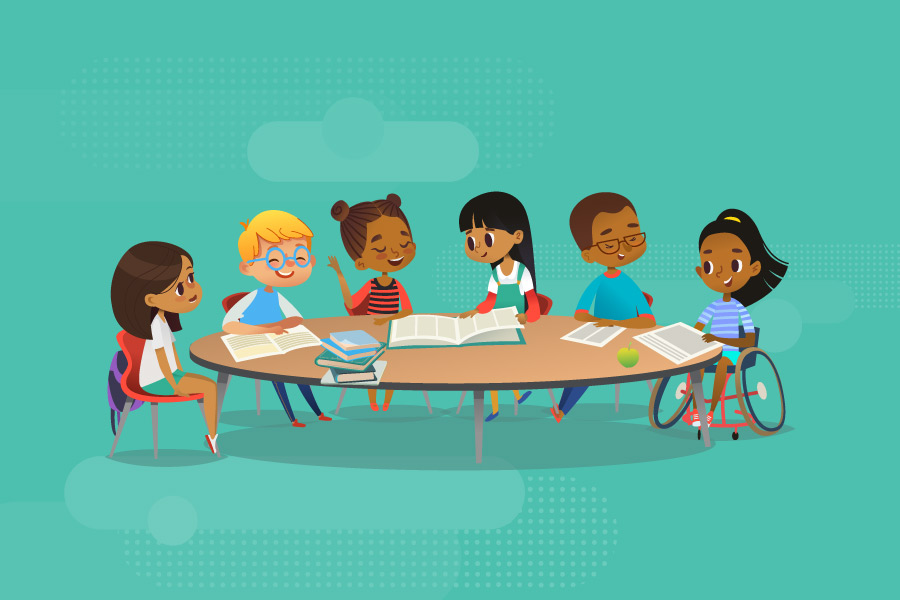Veteran teacher and TeacherVision Advisory board member Tina shares her top four early reading strategies, and includes teaching tips from her own practice. Try something new and add these to your teaching toolkit.

One of the leading predictors of future academic achievement is early reading success. Because early readers are just learning to read, many traditional reading strategies are not appropriate for them. It can be difficult to pinpoint effective reading approaches for the young learner. Find four fabulous early reading strategies below that you can easily implement in your classroom for your early readers.
1) Guided Reading
The International Reading Association, the National Association for the Education of Young Children, and the National Council of Teachers of English have each found that guided reading can be beneficial to young learners when used as part of a balanced literacy program. In fact, many reading programs focus on guided reading as the main component.
Guided reading is a teaching method in which an instructor works with a smaller group of students who share similar reading levels and skills. A lesson lasts about 15-25 minutes, and it should allow for students to use reading strategies they already know and apply them to reading a new text with teacher support.
Guided reading has been shown to support reading proficiency, build fluency, and strengthen specific skills focused on during instruction.
Teaching Tips for Guided Reading
Use the following procedure and suggested times for a Guided Reading lesson:
Identify and group students according to reading levels and skills.
- The ideal group should be no more than 6 students, but if your class size is large, groups with up to 8 students can still be effective.
- Groups of more than 8 students start to lose their efficacy.
Introduce the lesson (2-3 minutes).
- Identify troublesome vocabulary, and help students decode and define the words.
- Present any background knowledge the students may need.
- Assign the number of pages students should read.
Read the text (10 minutes).
- Students read to themselves, either silently or quietly.
- Pay attention to each student for a portion of the reading time, providing any support where needed.
- Discourage any poor reading habits.
- Identify any areas you should reteach.
Talk about the text (5 minutes).
- Engage in a conversation about the reading with the students.
- Answer any questions the students may have and clear up any misconceptions.
- Ask critical thinking and open-ended questions.
Teaching Objective (5 minutes).
- Teach one objective that students need to practice at the level you are teaching.
- Select an objective that is present in the text selection read by the students.
- Reference the text selection while teaching the objective.
Word Work (3-4 minutes).
- Plan activities that provide a hands-on experience to work with spelling or vocabulary words.
- Word work can be done using spelling words, vocabulary words from the text, or other words the students need to know.
- Examples include word sorts, spelling patterns, learning about word parts, and rainbow spelling words.
Independent Work
- Assign students an activity that assesses the objective taught.
- This can be for practice or a graded assignment.
2) Focus on Vocabulary
Even before kids begin to read, they learn a variety of vocabulary words used in various contexts and categories. A recent study in the Journal of Developmental and Behavioral Pediatrics found there is an estimated 1.4 million word gap between children entering kindergarten who had at least 5 books a day read to them compared to those who were not read to at all. This startling statistic further highlights the importance of having a focus on vocabulary for early learners. A higher vocabulary helps kids to develop their reading skills with more understanding and complexity.
Focusing on vocabulary simply involves a meaningful focus on teaching new vocabulary words. This does not have to be an entirely separate subject, but it is most effective when taught organically.
For example, if you are reading a book about apples, and you come to the word “orchard,” discuss this word with your students. It is likely many of them will not know its meaning, which is a prime learning opportunity. Some teaching moments will present themselves unplanned, but it is important to also plan ahead and integrate a focus on vocabulary as you teach other content.
Teaching Tips for Vocabulary Focus
Placing a focus on vocabulary can be worked into your daily routine in a number of ways. First, any time you read with students, especially as a group, point out the most important words and discuss them. Second, choose books purposefully to introduce topics and/or words students may not be familiar with. Next, build on the information students already know to introduce new information, thus increasing their background knowledge base, which is what we generally use to learn new information. Finally, incorporate activities and games that focus on learning new words, such as Vocabulary Bingo, Pictionary, or rhyming games and songs.
3) Making Predictions
Making predictions while reading is a great way to ensure that your students are not only paying attention, but are also comprehending what is being read. This is mainly due to the fact that when students make predictions, they are also asking questions about what they are reading, recalling facts from the text, rereading, and drawing conclusions.
Making predictions is simply trying to figure out what could or should logically happen next. But it’s more than a guess. When you ask a student to predict what will happen, he or she must incorporate a variety of skills. Then the student must infer meaning from all the information he or she has, making a prediction about the story.
Teaching Tips for Making Predictions
Making predictions is a great reading strategy to start with early in the school year. Even kids who aren’t actually reading yet can practice this skill by listening to the story, looking at the pictures, and thinking about what could happen next.
When practicing this skill, work on requiring students to provide evidence along with their predictions. “Why do you think that?” is an excellent question to ask to prompt students to support their predictions with information from the text, or to allow them to work through why their prediction may not be logical.
4) Checking for Comprehension
Checking for comprehension, in my opinion, is perhaps the most important reading strategy. I cannot count the number of times I’ve been fooled into thinking students understand every bit of what we’ve read, only to find out they understood nothing when I checked their comprehension of the information. If students don’t understand, or if they misunderstand, information, they can spend a whole lot of time learning the “wrong” things.
Checking for comprehension refers to assessing students to be sure they understand what they read. An assessment, however, is not always a test, or even on a piece of paper. This assessment can be a quick, oral check, such as asking a question. You could do a craft, or even have kids sort pictures on a storyboard.
Teaching Tips for Checking Comprehension
When working with early readers, the teacher will usually be the one checking for comprehension. However, you can introduce the idea that students can check for their own comprehension. If they don’t understand something, what should they do? They could ask a friend, look in the text, or ask the teacher. In addition, asking questions is a great strategy that helps to check comprehension. However, work on crafting questions ahead of time, so you can throw in a few that might require a bit more brain power. Graphic organizers are also a great tool. Even if you have non-readers and writers, you can give students pictures to sort for sequence of events, pictures to color for accuracy based on information in the text, or even a blank piece of paper for them to draw something specific from the story.
Teaching kids to read can be cumbersome, but oh, it is so worth it! Early readers certainly benefit from many of the same strategies that older readers do, but oftentimes, these strategies must be presented in a slightly different format. Hopefully, you have found some strategies and tips that you can integrate into your teaching routine that will be helpful for your little learners.
How do you teach early reading in your classroom? Share with us on Instagram, Facebook, Twitter, and Pinterest.
Tina Wheeler is an elementary teacher in a combined 3rd/4th grade classroom at a small private school in Cuba, Missouri. She has been an educator since 2005, working in both the general and special education classrooms with students ranging in ages from 3 years old to adulthood. When Tina is not teaching, she works as a freelance writer. She also shares teaching tips and tricks on her blog at Miss Tina’s Room.


